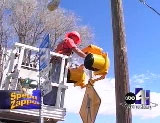It started last April with a plea from a grieving mother whose four-year-old son was hit and killed on a dangerous stretch of 3500 South and 8150 West in Magna. It is the same spot where a 15-year-old boy was also hit and seriously injured.

Meshell Hayes wanted a crosswalk put in so no one else would have to have to grieve.
Through ABC 4’s requests, the Utah Department of Transportation conducted a traffic study and found 3500 South and 8150 West warranted a crosswalk and one was put in, but unfortunately it didn’t prevent drivers from slowing down, stopping, or even noticing pedestrians trying to cross the street. ABC 4 caught drivers blatantly ignoring pedestrians and showed the findings to UDOT. Another request was made for flashing warning lights. UDOT answered that request.
On a blustery April day, Utah Department of Transportation workers showed up at 3500 South 8150 West with something new in their truck: groundbreaking technology, a state-of-the-art solar-powered flashing light system that costs taxpayers less to run and install. UDOT chose this site as the first application for the new system. Two flashing lights are installed above existing warning signs, one on each side of the street. A separate pole at each end of the crosswalk houses a radio receiver and pedestrian activation button. When someone wants to use the crosswalk, they push the button. It sends a radio signal that activates the flashing lights.
Normal installation would have required trenching across the roadway and connecting to a power source. It is a process that takes more than a week of construction to complete at a cost of around $20,000. The solar-powered lights are installed in just a few hours and require no outside source of power. They can store a charge for up to a month without sunlight. The batteries last five years and cost around $500 to replace, a significant savings in electricity costs. The total cost to install the new system is $6,000 compared to more than twice that much with the old system.
Several people who normally use the crosswalk were excited about the new improvement, telling ABC 4 they will now feel safer as they use the crosswalk. ABC 4’s cameras actually caught something that up until now has been a rare sight: Drivers slowing when the flashing lights are activated who actually stop when people cross.
Because of the simple installation and low maintenance cost, UDOT plans to use the new system in rural areas where power hookups are not close by. It could be an economical solution for smaller communities as well.
